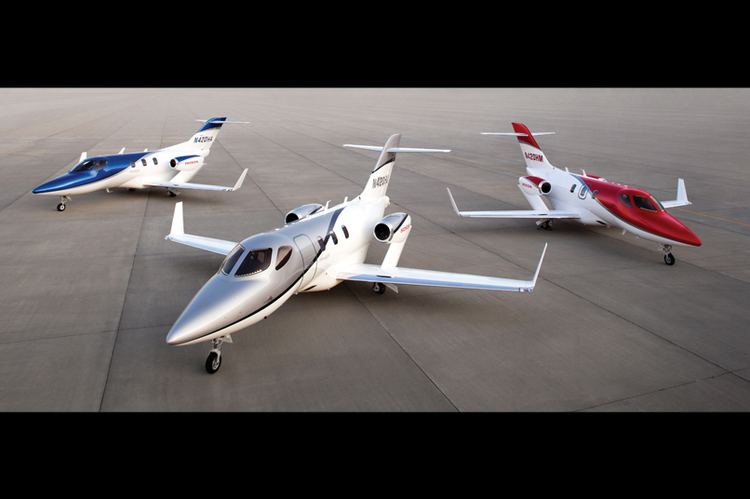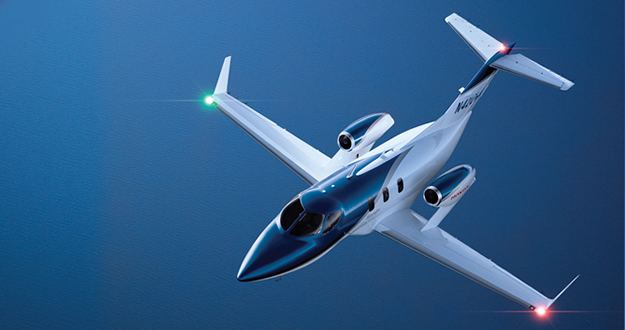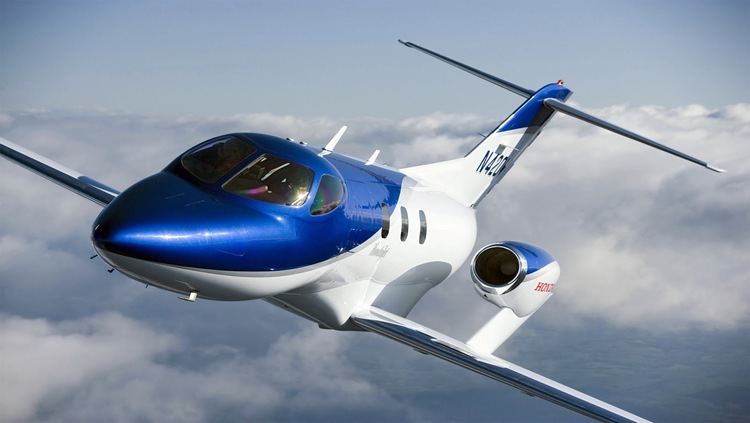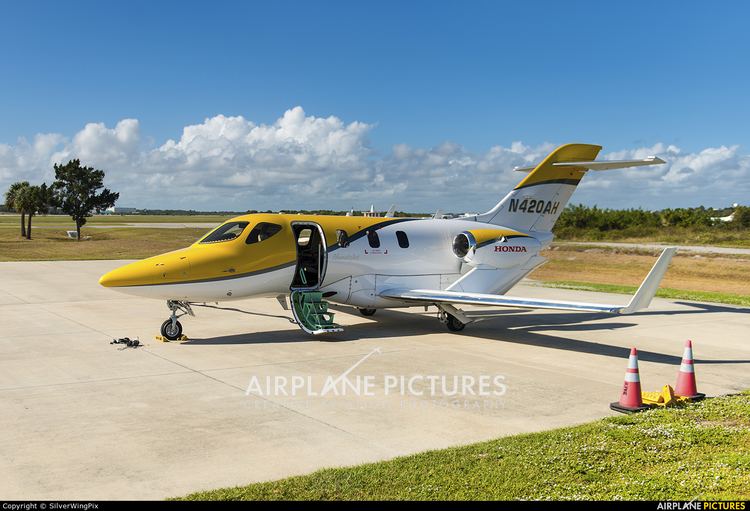Range 2,185 km Wingspan 12 m | Top speed 778 km/h Length 13 m First flight December 3, 2003 | |
 | ||
Unit cost 3,650,000–3,650,000 USD (2006) | ||
Honda ha 420 hondajet business jet promo video
The Honda HA-420 HondaJet is the first aircraft developed by Honda Aircraft Company. The light business jet was designed in Japan and then developed and manufactured in Greensboro, North Carolina in the United States.
Contents

Development

Honda began to study small sized business jets in the late 1980s, using engines from other manufacturers. The Honda SHM-1/MH01 turboprop tested laminar flow wings, and the Honda MH02 was fabricated and assembled at Mississippi State University's Raspet Flight Research Laboratory in the late 1980s and early 1990s. The MH02 was a prototype using carbon fiber/epoxy composite materials and was the first all-composite light business jet to fly. Flight testing on the MH02 continued through 1996, after which the aircraft was shipped to Japan.

Designer Michimasa Fujino sketched the HondaJet in 1997, and the concept was locked in 1999. Testing in the Boeing windtunnel indicated a valid concept in 1999.

A proof-of-concept (but not production-ready) version of the HondaJet first flew on 3 December 2003 at Piedmont Triad International Airport in Greensboro, North Carolina, United States. Honda approved commercial development of the HondaJet in 2004. The HondaJet made its world debut on 28 July 2005, at the annual EAA AirVenture Oshkosh airshow. Honda announced on 25 July 2006 at that year's Airventure that it would commercialize the HondaJet.

The first FAA-conforming (built to Federal Aviation Administration rules) HondaJet achieved its first flight on 20 December 2010. The first flight of the first production HondaJet occurred on 27 June 2014, and it was displayed at that year's AirVenture on 28 July. Four HondaJets had test-flown 2,500 hours as of 2015.

The HA-420 aircraft program itself was plagued by delays. The initial planned certification date was "Late 2010", but in Spring 2009 was delayed by a year. In May 2010, the projected certification date was late 2012. The program was incrementally delayed several more times.
The HondaJet was awarded "Provisional FAA Certification" in March 2015, enabling continued production and demonstration flights, but not customer delivery. The aircraft received its FAA type certificate in December 2015. A HondaJet toured Japan and Europe in 2015, and the type received European Aviation Safety Agency (EASA) certification in May 2016.
Production
The production aircraft are built at Piedmont Triad Airport. Construction of the factory began in 2007 and was completed in late 2011. In early 2015, there were twelve aircraft in final assembly and five more in earlier stages of production. Twenty aircraft were in production by May 2015. Honda estimated it would produce 40 aircraft in the first full year and up to 60 each year after that. The engine factory achieved certification in March 2015.
Honda delivered the first customer aircraft on December 23, 2015 at its world headquarters in Greensboro, North Carolina First delivery of a HondaJet to a European aircraft dealer took place in April 2016. About 20 percent of the approximately 100 aircraft on order are destined for European customers.
Honda plans to ramp up production to 80 units per year after March 2019. Sixteen aircraft were delivered in the first three quarters of 2016, reaching a 36 per year production rate.
Design
The HondaJet is a low-wing monoplane with a conventional structure, it has a mainly composite fuselage and an aluminium wing. The aircraft is powered by two GE Honda Aero Engines HF-120 turbofans mounted on pylons above the wing. It has a retractable tricycle landing gear with both single wheeled main and nose landing gear.
Several aircraft with overwing podded engines have been tested, for various reasons. The configuration has been used on seaplanes, such as the Dornier Do X from 1929 and the modern jet-engined Beriev Be-200. It was also used on the VFW-Fokker 614, a 44-seat German jet airliner, in the early 1970s. The VFW 614 was designed among others for eliminating ingestion problems and weight. Others include NASA's Quiet Short-Haul Research Aircraft around 1980 and the Scaled Composites Triumph 8-place business jet in 1988.
The HondaJet’s overwing engine mount configuration was designed to maximize cabin space, and achieve lower wave drag at a high Mach number. The nose and wing are designed for laminar flow, and the main fuselage has a constant profile, making an eventual stretch easier. The combination of engine placement, wing and fuselage was achieved using computer simulations and wind tunnels. Honda claims that the combination of lightweight materials, aerodynamics and efficient engines gives the HondaJet up to 20% better fuel efficiency than similar aircraft.
Honda began developing its own small turbofan engine, the HF118, in 1999. This led to the HF120, developed with GE Aviation under the GE-Honda partnership. The HF120 was test-flown on a Cessna Citation CJ1. The engine features a single fan, a two-stage compressor and a two-stage turbine. The GE Honda HF120 received FAA type certification on 13 December 2013, and production certification in 2015.
The passenger area is 5.43 m (17.80 ft) long and has an enclosed lavatory. The semi-round cabin is 12.1 ft long, 1.52 m (5.00 ft) wide, and 1.46 m (4.80 ft) high.
The aircraft is equipped with a touchscreen 3-display Garmin G3000 glass cockpit system (i.e. most of the cockpit readouts are presented on flat-panel displays).
Fujino received the 2014 International Council of the Aeronautical Sciences award for the design as well as an Aviation Industry Leader of the Year Award.
In 2014, the aircraft was awarded a 'Best of What's New' title by Popular Science magazine.
Specifications
Data from Aviation International News
General characteristics
Performance
